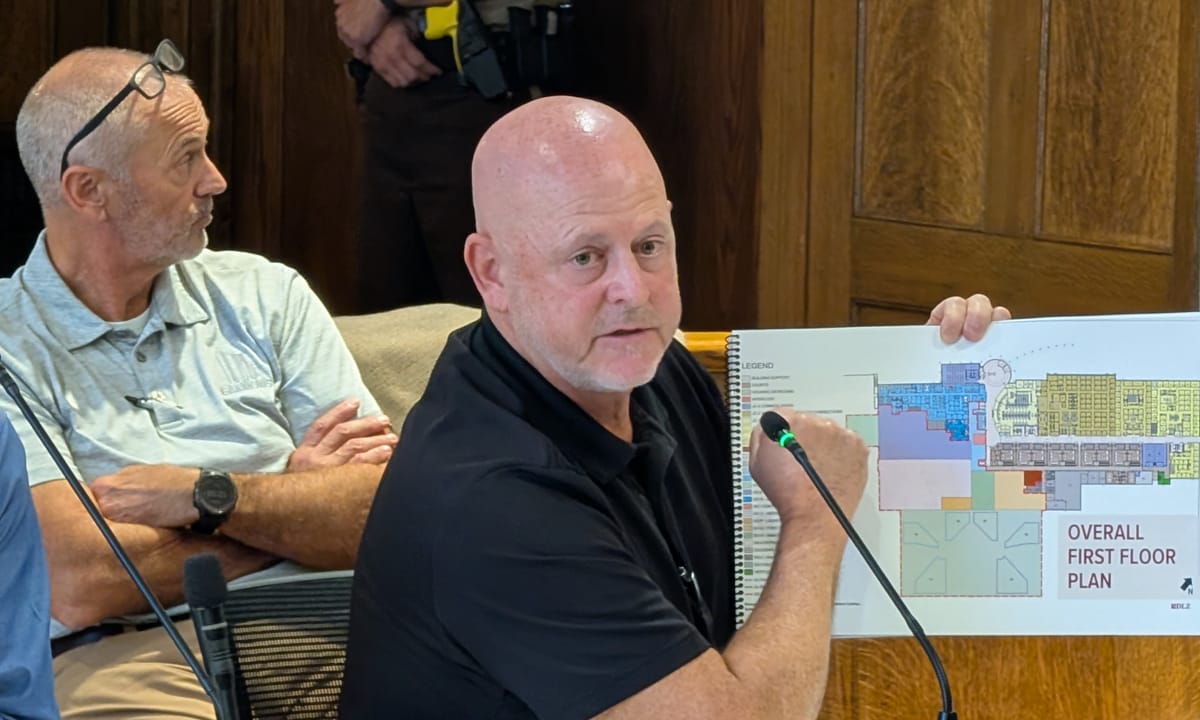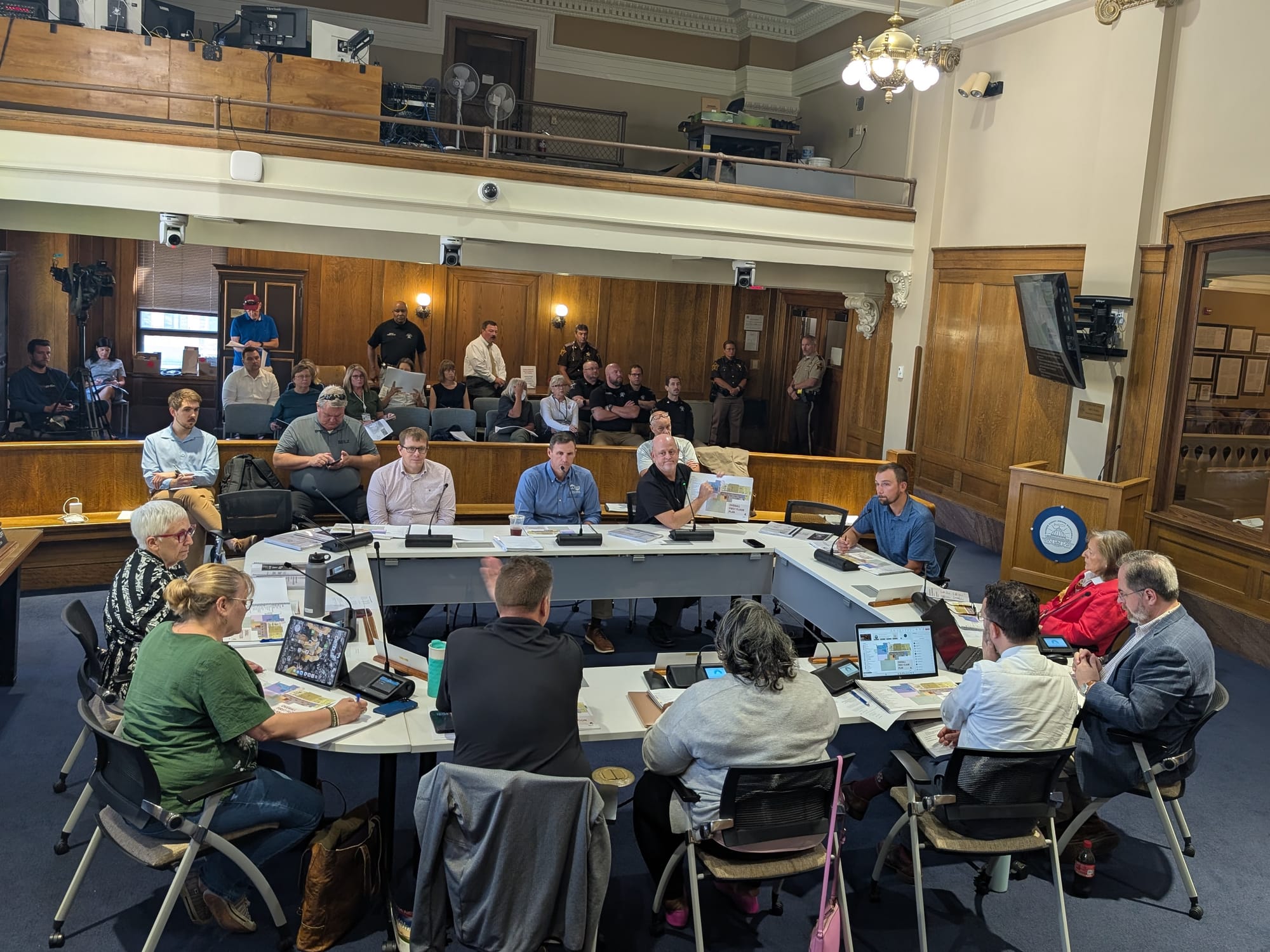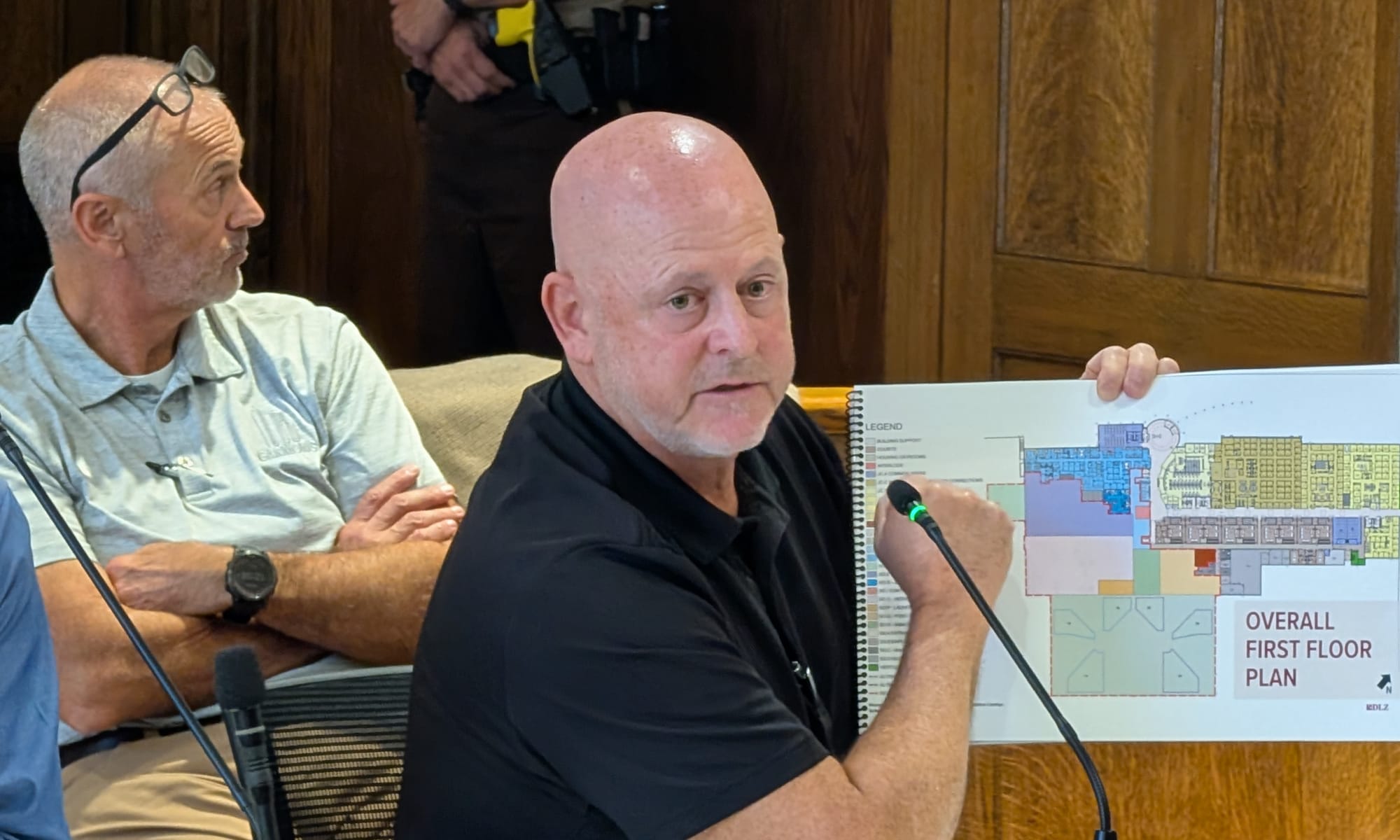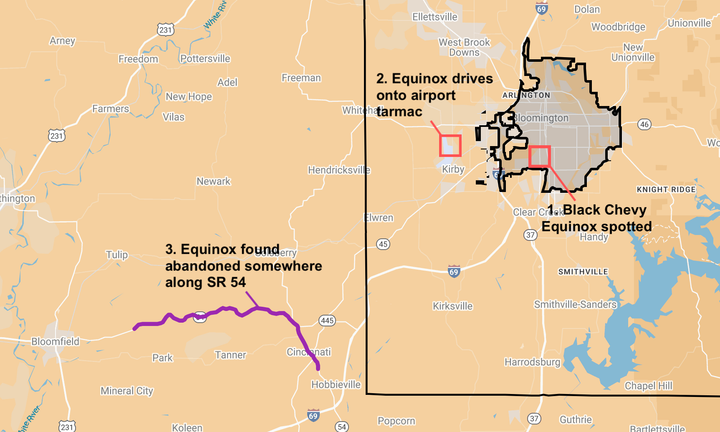Monroe County OKs next step in jail design, amid funding uncertainty
DLZ Corporation is going ahead with the design development phase for the planning of a new jail and justice center to be located at North Park, between Bloomington and Ellettsville. That’s after Monroe County commissioners voted to accept DLZ's schematic designs and move ahead to the next step.



Left:The Monroe County council holds a work session on the jail schematics. Right: DLZ Corporation’s Scott Carnegie presents the most recent schematic to the county council. (Dave Askins, Aug. 29, 2025)
DLZ Corporation is going ahead with the design development phase for the planning of a new jail and justice center to be located at North Park, between Bloomington and Ellettsville.
That’s after the three-member board of Monroe County commissioners took a unanimous 3–0 vote at its regular meeting on Thursday morning, to accept DLZ’s schematic designs and move ahead to the next step.
The action by commissioners sets the stage for the county council to consider the appropriation required to pay DLZ for its work, possibly as soon as its next regular meeting on Sept. 16, as well as another appropriation to finally close the deal on the land at North Park.
The fact that the county government does not currently have the ability to finance the project makes for a big cloud of uncertainty. But commissioners say they’re moving ahead in order to send a clear message to the state legislature and to the ACLU, that they are serious about addressing issues of constitutional care at the jail. The jail currently operates under a private settlement agreement with the ACLU over a lawsuit filed in 2008 about overcrowding at the jail.
Commissioner Jody Madeira put it like this at Thursday’s meeting: “There is a legislature that’s looking at us to move ahead. And so we need to send a very clear message that we are moving ahead. And I think this is the clearest way to send this message.”
Commissioners are hoping that backchannel lobbying efforts will cause the legislature to rethink specific aspects of SEA 1, like the prohibition against a local governmental unit pledging more than 25% of revenue from local income taxes towards a bond. Commissioner Julie Thomas wanted to know from DLZ Corporation’s Scott McKinzie what the timeline for the project looks like, “if we get through the legislative issues from the state.”
The timeline, according to McKinzie, still calls for the new facility to be completed in 2029. DLZ’s next steps will be presentation to commissioners of the design development package in mid-December, followed by the construction documents in late June 2026, with the construction start hoped for by October 2026. That timeline has slipped about three months from the one presented by DLZ earlier this year in April.
There’s no question that Monroe County doesn’t have the have the ability to pay for the new facility all at one time, given the constraints of SEA 1, which revised the structure of property taxes and local income taxes in the state of Indiana. That’s unless the county were to put the question to voters as a referendum, for which there seems to be little appetite, except as a last resort.
That’s even though the cost estimates for the schematics presented by DLZ this past week are back down to the ballpark of the working budget the county council had previously set, which is around $225 million.
The estimated cost was reduced from escalated figures by scaling down the number and size of offices in the justice facility. The total floor area in the sketches presented in April came to about 271,000 square feet compared to the 237,000 square feet in the most recent schematics, which is about a 12.5% reduction. The schematics approved by commissioners on Thursday include 404 jail beds, with a building shell that could fit 96 more beds.
The practical consideration of the cost, and how realistic it is to think that the state legislature will amend SEA 1 during its 2026 session, is likely to get some air time in the coming weeks, when the county council considers the appropriations for DLZ’s work and for the land acquisition cost.
DLZ’s contract calls for payment of 2% of the construction cost, and $100,000 a month during the construction period. The land deal for North Park carries a $11.375 million price tag.
A week ago on Friday (Aug. 29) when the county council received DLZ’s presentation on the latest schematics, councilor David Henry was keen to focus on a scenario where the state legislature does not amend SEA 1 in a way that allows for Monroe County to finance the justice center project all in one go.
Henry asked Carnegie: “If this project had to be phased—where we had to select or prioritize what gets built first, based on the budget constraints placed on us by the state of Indiana … is there a way to phase this project and prioritize certain aspects of it, or break it into sections?” The idea would be to build in the short term what is minimally required to satisfy the requirements for constitution care at the jail in the context of the ACLU lawsuit.
The short answer is that such a phasing is possible. The DLZ team is aware of the possibility, and Carnegie told The B Square that his team has “brainstormed” certain phasing alternatives. But the direction given by county commissioners on Thursday did not include any phasing options.
This week, Henry told The B Square that based on his own conversations with state legislators, he does not currently think that in early 2026 the Indiana General Assembly would be inclined to amend SEA 1. Henry put it like this: “The temperature in Indianapolis to revisit the governor’s signature tax legislation is pretty cold.” Henry allowed, “Perhaps the commissioners have different insights than I do.” For his part, though, Henry called the idea that there would be legislative action on SEA 1 in early 2026 “wish thinking.”
Last Friday, councilor Trent Deckard indicated a hope that legislatures would notice the operational pressures on local government across the state that have been caused by SEA 1. Deckard said, “Anyone watching our budget sessions can already see the impact of what’s happening.” Deckard added, “I hope that folks in Indianapolis are watching this closely, because I can’t get through a day without one of our local government units … contacting me and saying, let me paraphrase, ‘I feel like the state has slit our throat and wants us to go walking around providing services.’”
Last Friday, councilor Peter Iversen pointed to the urgency of the jail project, referring to the recent shutdowns due to the discovery and treatment of mold at the current justice building. Iversen said, “I don’t think we can let today go by without acknowledging that the mold crisis in the existing justice complex has heightened the urgency for us to do something.”
After DLZ’s payment and the land acquisition cost, the county council will face the bigger question of funding the whole project next year, likely after the state legislature has either acted to amend SEA 1, or not. But the project timeline distributed by DLZ on Friday calls for the bonding process to begin as early as January 2026.




Comments ()